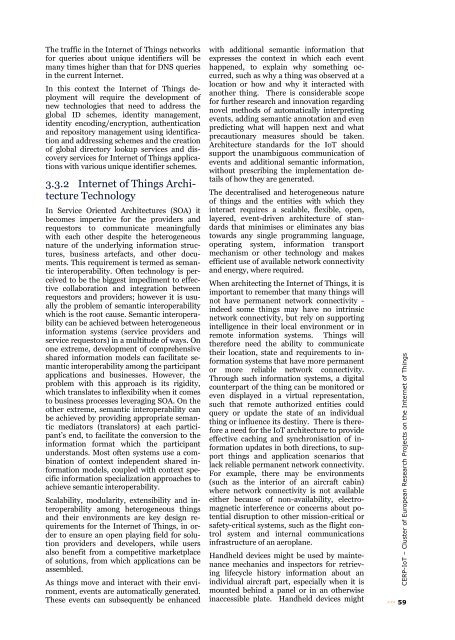Vision and Challenges for Realising the Internet of Things
Vision and Challenges for Realising the Internet of Things
Vision and Challenges for Realising the Internet of Things
Create successful ePaper yourself
Turn your PDF publications into a flip-book with our unique Google optimized e-Paper software.
The traffic in <strong>the</strong> <strong>Internet</strong> <strong>of</strong> <strong>Things</strong> networks<br />
<strong>for</strong> queries about unique identifiers will be<br />
many times higher than that <strong>for</strong> DNS queries<br />
in <strong>the</strong> current <strong>Internet</strong>.<br />
In this context <strong>the</strong> <strong>Internet</strong> <strong>of</strong> <strong>Things</strong> deployment<br />
will require <strong>the</strong> development <strong>of</strong><br />
new technologies that need to address <strong>the</strong><br />
global ID schemes, identity management,<br />
identity encoding/encryption, au<strong>the</strong>ntication<br />
<strong>and</strong> repository management using identification<br />
<strong>and</strong> addressing schemes <strong>and</strong> <strong>the</strong> creation<br />
<strong>of</strong> global directory lookup services <strong>and</strong> discovery<br />
services <strong>for</strong> <strong>Internet</strong> <strong>of</strong> <strong>Things</strong> applications<br />
with various unique identifier schemes.<br />
3.3.2 <strong>Internet</strong> <strong>of</strong> <strong>Things</strong> Architecture<br />
Technology<br />
In Service Oriented Architectures (SOA) it<br />
becomes imperative <strong>for</strong> <strong>the</strong> providers <strong>and</strong><br />
requestors to communicate meaningfully<br />
with each o<strong>the</strong>r despite <strong>the</strong> heterogeneous<br />
nature <strong>of</strong> <strong>the</strong> underlying in<strong>for</strong>mation structures,<br />
business artefacts, <strong>and</strong> o<strong>the</strong>r documents.<br />
This requirement is termed as semantic<br />
interoperability. Often technology is perceived<br />
to be <strong>the</strong> biggest impediment to effective<br />
collaboration <strong>and</strong> integration between<br />
requestors <strong>and</strong> providers; however it is usually<br />
<strong>the</strong> problem <strong>of</strong> semantic interoperability<br />
which is <strong>the</strong> root cause. Semantic interoperability<br />
can be achieved between heterogeneous<br />
in<strong>for</strong>mation systems (service providers <strong>and</strong><br />
service requestors) in a multitude <strong>of</strong> ways. On<br />
one extreme, development <strong>of</strong> comprehensive<br />
shared in<strong>for</strong>mation models can facilitate semantic<br />
interoperability among <strong>the</strong> participant<br />
applications <strong>and</strong> businesses. However, <strong>the</strong><br />
problem with this approach is its rigidity,<br />
which translates to inflexibility when it comes<br />
to business processes leveraging SOA. On <strong>the</strong><br />
o<strong>the</strong>r extreme, semantic interoperability can<br />
be achieved by providing appropriate semantic<br />
mediators (translators) at each participant’s<br />
end, to facilitate <strong>the</strong> conversion to <strong>the</strong><br />
in<strong>for</strong>mation <strong>for</strong>mat which <strong>the</strong> participant<br />
underst<strong>and</strong>s. Most <strong>of</strong>ten systems use a combination<br />
<strong>of</strong> context independent shared in<strong>for</strong>mation<br />
models, coupled with context specific<br />
in<strong>for</strong>mation specialization approaches to<br />
achieve semantic interoperability.<br />
Scalability, modularity, extensibility <strong>and</strong> interoperability<br />
among heterogeneous things<br />
<strong>and</strong> <strong>the</strong>ir environments are key design requirements<br />
<strong>for</strong> <strong>the</strong> <strong>Internet</strong> <strong>of</strong> <strong>Things</strong>, in order<br />
to ensure an open playing field <strong>for</strong> solution<br />
providers <strong>and</strong> developers, while users<br />
also benefit from a competitive marketplace<br />
<strong>of</strong> solutions, from which applications can be<br />
assembled.<br />
As things move <strong>and</strong> interact with <strong>the</strong>ir environment,<br />
events are automatically generated.<br />
These events can subsequently be enhanced<br />
with additional semantic in<strong>for</strong>mation that<br />
expresses <strong>the</strong> context in which each event<br />
happened, to explain why something occurred,<br />
such as why a thing was observed at a<br />
location or how <strong>and</strong> why it interacted with<br />
ano<strong>the</strong>r thing. There is considerable scope<br />
<strong>for</strong> fur<strong>the</strong>r research <strong>and</strong> innovation regarding<br />
novel methods <strong>of</strong> automatically interpreting<br />
events, adding semantic annotation <strong>and</strong> even<br />
predicting what will happen next <strong>and</strong> what<br />
precautionary measures should be taken.<br />
Architecture st<strong>and</strong>ards <strong>for</strong> <strong>the</strong> IoT should<br />
support <strong>the</strong> unambiguous communication <strong>of</strong><br />
events <strong>and</strong> additional semantic in<strong>for</strong>mation,<br />
without prescribing <strong>the</strong> implementation details<br />
<strong>of</strong> how <strong>the</strong>y are generated.<br />
The decentralised <strong>and</strong> heterogeneous nature<br />
<strong>of</strong> things <strong>and</strong> <strong>the</strong> entities with which <strong>the</strong>y<br />
interact requires a scalable, flexible, open,<br />
layered, event-driven architecture <strong>of</strong> st<strong>and</strong>ards<br />
that minimises or eliminates any bias<br />
towards any single programming language,<br />
operating system, in<strong>for</strong>mation transport<br />
mechanism or o<strong>the</strong>r technology <strong>and</strong> makes<br />
efficient use <strong>of</strong> available network connectivity<br />
<strong>and</strong> energy, where required.<br />
When architecting <strong>the</strong> <strong>Internet</strong> <strong>of</strong> <strong>Things</strong>, it is<br />
important to remember that many things will<br />
not have permanent network connectivity -<br />
indeed some things may have no intrinsic<br />
network connectivity, but rely on supporting<br />
intelligence in <strong>the</strong>ir local environment or in<br />
remote in<strong>for</strong>mation systems. <strong>Things</strong> will<br />
<strong>the</strong>re<strong>for</strong>e need <strong>the</strong> ability to communicate<br />
<strong>the</strong>ir location, state <strong>and</strong> requirements to in<strong>for</strong>mation<br />
systems that have more permanent<br />
or more reliable network connectivity.<br />
Through such in<strong>for</strong>mation systems, a digital<br />
counterpart <strong>of</strong> <strong>the</strong> thing can be monitored or<br />
even displayed in a virtual representation,<br />
such that remote authorized entities could<br />
query or update <strong>the</strong> state <strong>of</strong> an individual<br />
thing or influence its destiny. There is <strong>the</strong>re<strong>for</strong>e<br />
a need <strong>for</strong> <strong>the</strong> IoT architecture to provide<br />
effective caching <strong>and</strong> synchronisation <strong>of</strong> in<strong>for</strong>mation<br />
updates in both directions, to support<br />
things <strong>and</strong> application scenarios that<br />
lack reliable permanent network connectivity.<br />
For example, <strong>the</strong>re may be environments<br />
(such as <strong>the</strong> interior <strong>of</strong> an aircraft cabin)<br />
where network connectivity is not available<br />
ei<strong>the</strong>r because <strong>of</strong> non-availability, electromagnetic<br />
interference or concerns about potential<br />
disruption to o<strong>the</strong>r mission-critical or<br />
safety-critical systems, such as <strong>the</strong> flight control<br />
system <strong>and</strong> internal communications<br />
infrastructure <strong>of</strong> an aeroplane.<br />
H<strong>and</strong>held devices might be used by maintenance<br />
mechanics <strong>and</strong> inspectors <strong>for</strong> retrieving<br />
lifecycle history in<strong>for</strong>mation about an<br />
individual aircraft part, especially when it is<br />
mounted behind a panel or in an o<strong>the</strong>rwise<br />
inaccessible plate. H<strong>and</strong>held devices might<br />
CERP-IoT – Cluster <strong>of</strong> European Research Projects on <strong>the</strong> <strong>Internet</strong> <strong>of</strong> <strong>Things</strong><br />
59
















